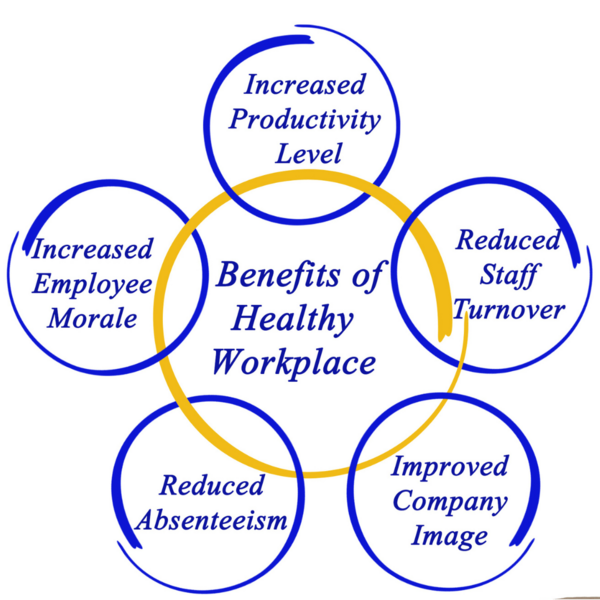How Is Wellbeing Measured In The Workplace? 3 Proven Methods

If you're reading this article, you probably know that workplace wellbeing is no longer a luxury, but a necessity for organisations that strive for growth and success. To me as a nutritional medicine practitioner with a prior career at Microsoft, that's like saying wellbeing isn't essential for productivity and that is simply hogwash! But, there's one thing no one likes to talk about. Namely, how is wellbeing measured in the workplace?
That's what I'm going to cover today.
In this article, I'll explain the importance of measuring workplace wellbeing and provide an overview of how you can do it. I'll also detail a few methods for taking action to improve the wellbeing of our most valuable asset in the workplace- YOU- the employee. when needed.
Understanding Workplace Wellbeing
Before delving into the specifics of measuring workplace wellbeing, it's important to understand what it is.
Workplace wellbeing is defined as an environment that supports and promotes health, safety, security, and satisfaction for employees. It can include many different elements such as ergonomic furniture and lighting, access to mental health services, resources to help employees support physical and mental health and even social elements such as team-building events and recognition programs.
The goal of wellbeing programs is to foster an environment in which your employees thrive. This will increase productivity, engagement, and overall satisfaction with their job.
In return, companies enjoy a variety of benefits such as increased productivity, better employee retention, and improved overall company culture. Not to mention the cost savings that come from reduced turnover and absenteeism.
The Value of Measuring Workplace Wellbeing
An important element in maintaining an environment that supports and promotes workplace wellbeing is understanding how and when to measure it.
By measuring employee wellbeing in your workplace, your company can identify areas for improvement and make changes that establish a more supportive environment for their employees. This benefits your business in many ways, including:
 Better Decision-Making: A workplace that prioritises wellbeing fosters a mindset of clarity, reducing stress and anxiety which often impair decision-making abilities. Employees who feel well-rested and valued are more likely to make good, informed decisions.
Better Decision-Making: A workplace that prioritises wellbeing fosters a mindset of clarity, reducing stress and anxiety which often impair decision-making abilities. Employees who feel well-rested and valued are more likely to make good, informed decisions.- Innovation and Creativity: A healthy and happy work environment stimulates the mind, sparking creativity and innovation. Employees who feel comfortable in their workplace are more likely to share and implement innovative ideas.
- Attracting Talent: A company known for its emphasis on employee wellbeing is more likely to attract top talent. Job seekers are increasingly prioritising a healthy work environment in their job search.
- Brand Reputation: Organisations that prioritise employee wellbeing often find their brand reputation is improved. This can help in attracting new customers, investors, and partners, creating a positive impact on the organization's bottom line.
- Lower Healthcare Costs: Companies focused on employee wellness report lower healthcare costs. By providing resources for a healthy lifestyle, companies can help mitigate the risk of chronic diseases, leading to lower healthcare costs.
- Increased Engagement & Productivity. When employees feel happy and healthy, they are more productive and engaged with their work. Why? Because they feel secure in their environment and empowered to do their best.
- Retention Of Employees. Companies that foster workplace wellbeing are more likely to attract and retain talent. This means less turnover, which can save the company money in recruitment costs as well as create a more stable environment for everyone on staff.
- Improved Company Culture. A positive workplace atmosphere helps to foster collaboration and open communication between departments, resulting in a better overall company culture. This is beneficial for both employees and the organization as a whole.
Workplace wellbeing, when effectively nurtured, leads to many benefits advantageous to both employees and the organisation.
This is a relatively new space for corporates. So let's look at when and how to work on it.
When to Measure Workplace Wellbeing
Now that you understand the value of measuring workplace wellbeing, let's talk about when it should be done.
There are some key indicators to watch out for that indicate the need to measure employee wellbeing, such as:
- Low morale
- Poor performance
- Increased stress levels
- A decrease in creativity and innovation
- High turnover rates
If any of these indicators are present, it’s time to measure your employee wellness as soon as possible.
3 Tools For Measuring Workplace Wellbeing
So, you've noticed a few problems cropping up. It's time to take action.
The first step is to measure the wellbeing of your employees. There are several tools and strategies that can be used for this purpose, such as:
- Employee Satisfaction Surveys: Surveys provide a direct way to obtain feedback from employees about their current level of satisfaction with their job and working environment. They’re a perfect way to identify areas for improvement.
- Employee Retention: Tracking employee retention is an important way to measure how well the workplace is meeting the needs of your employees. If you find employees are leaving after a short period, it may be time to take a closer look at their experience and make changes.
- Employee Motivation: Employee motivation is an important ingredient in the success of your company and an important indicator of workplace wellbeing. So being able to recognise the signs of low motivation and taking action quickly is key. Look for:
- Decreased productivity
- Increased tardiness/absenteeism
- Changes in behaviour or personality
- Decreased quality of work
- Higher than usual turnover
Creating a regular practice of measuring these KPIs of wellbeing will allow you to quickly identify areas of concern and address them before they become a bigger issue.
Taking Action To Support Your Employees’ Wellbeing
Once you have identified the need to take action, it's time to design a plan to support the wellbeing of your employees.
There are several steps you can take to address employee wellness in the workplace:
- Build a culture of open communication: Encourage employees to share their thoughts and feelings openly with management so they feel heard and supported.
- Invest in employee development: Provide on-the-job training, as well as opportunities for career growth. This will show your commitment to their future success and foster an environment of trust and respect.
- Prioritise work/life balance: Set realistic expectations and allow employees to take breaks when needed to help them feel less overwhelmed. Additionally, providing flexible working options when possible can also go a long way in improving employee morale.
- Implement wellness initiatives: Offer resources to help your employees establish healthy habits for better sleep, nutrition, and overall wellness. An easy way to do this is through online courses that allow them to learn at times convenient to them and at their own pace.
Rather than gifting a massage or a yoga class, imagine adding to the wellbeing of your organisation by giving your employees CPD points that are mandatory for their industry (usually out of their pocket) PLUS education for their wellbeing at the same time! This is one of the simplest and most cost-effective ways to implement a wellness initiative at your business. Visit this page for more information.
Measure Workplace Wellbeing & Take Action
The value of a healthy workplace and how to measure it cannot be overstated. Not only does it create a positive work environment for employees, but it can also result in increased productivity, improved brand reputation, lower healthcare costs, and reduced employee turnover.
By regularly measuring the level of employee wellbeing in your workplace and then taking action to support it, you will not only create a healthier environment for your team but also reap the benefits of an engaged and productive workforce.
So start taking action today and enjoy the benefits!
Any questions, thoughts, comments, feedback? Please share as we truly value efforts to create a positive wellness culture in your professional and family life.
Yours in good health & a bit of dark chocolate.
Michele.
Categories
- A Healthy View (510)
- Nutrition (214)
- Snack Recipes (56)
- Free Recipes (232)
- Breakfast Recipes (22)
- Media (86)
- Sleep (7)
- Mental Health (33)
- Sugar (15)
- Weight Loss (41)
- Uncategorised (1)
- Christmas Recipes (14)
- Dinner Recipes (113)
- Dessert Recipes (20)
- Easter Recipes (9)
- Sauce & Dip Recipes (12)
- Hormone Health (20)
- Workplace Wellbeing (27)
- Soup Recipes (12)
- Curry Recipes (8)
- Chicken Dinner Recipes (29)
- Seafood Recipes (12)
- Chilli Recipes (5)
- Salad Recipes (9)
- Mexican Recipes (11)
- Productivity (7)
- Energy & Vitality (5)
- Gut Health (14)
- Stress (3)
- Brain Health (3)
- gut health (1)
- energy (1)
- calories (1)
Ready to take the next step?
Explore our full range of wellbeing courses and start your journey today.

Michele Chevalley Hedge is a qualified Nutritional Medicine Practitioner, speaker, and best-selling author has delivered 600+ keynotes for leading global brands, including Microsoft, Accenture, American Express, Apple, ANZ, CBRE, the Australian Government, and more.
Michele’s nutrition retreats, wellness courses, books, articles, and corporate health programs are backed by peer-reviewed research on workplace well-being, nutrition, stress, and mental health. A regular guest on Channel 7, Sunrise, and The Today Show and contributor to The Sydney Morning Herald, Body & Soul, and The Daily Mail, Michele is also an Ambassador for Cure Cancer and the Heart Research Institute.



0 comments
Leave a comment
Please log in or register to post a comment